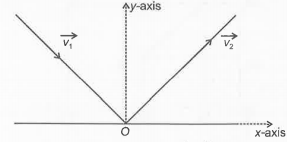A ball is thrown onto a floor at an angle. If its velocity vector is 4ˆi−3ˆj(ms) and restitution coefficient is 23 2 3 then, the velocity by which itr ebounds is
−4ˆi+2ˆj
−4ˆi+3ˆj
4ˆi+2ˆj
4ˆi−2ˆj
To find the velocity with which the ball rebounds after hitting the floor, we can follow these steps:
Step 1: Identify the initial velocity vector
The initial velocity vector of the ball is given as:
→vi=4^i−3^jm/s
Here, 4^i represents the horizontal component, and −3^j represents the vertical component (downward).
Step 2: Understand the coefficient of restitution
The coefficient of restitution e is given as:
e=23
This coefficient relates the velocities before and after the collision. Specifically, it is defined as:
e=Velocity of separationVelocity of approach
Step 3: Determine the velocity components
Since the collision occurs with the floor, the horizontal component of the velocity remains unchanged. Thus:
vix=vfx=4m/s
For the vertical component, we need to find the final vertical velocity vfy after the collision.
Step 4: Apply the coefficient of restitution
The velocity of approach in the vertical direction is the negative of the initial vertical component (since it is downward):
Velocity of approach=−viy=3m/s
Using the coefficient of restitution:
e=vfyviy
Substituting the known values:
23=vfy3
Step 5: Solve for the final vertical velocity
To find vfy, we rearrange the equation:
vfy=23×3=2m/s
Since the ball rebounds upward, we take this as positive:
vfy=2m/s
Step 6: Write the final velocity vector
Now we can write the final velocity vector after the rebound:
→vf=4^i+2^jm/s
Conclusion
Thus, the velocity with which the ball rebounds is:
→vf=4^i+2^jm/s
---
The initial velocity vector of the ball is given as:
→vi=4^i−3^jm/s
Here, 4^i represents the horizontal component, and −3^j represents the vertical component (downward).
The coefficient of restitution e is given as:
e=23
This coefficient relates the velocities before and after the collision. Specifically, it is defined as:
e=Velocity of separationVelocity of approach
Since the collision occurs with the floor, the horizontal component of the velocity remains unchanged. Thus:
vix=vfx=4m/s
For the vertical component, we need to find the final vertical velocity vfy after the collision.
The velocity of approach in the vertical direction is the negative of the initial vertical component (since it is downward):
Velocity of approach=−viy=3m/s
Using the coefficient of restitution:
e=vfyviy
Substituting the known values:
23=vfy3
To find vfy, we rearrange the equation:
vfy=23×3=2m/s
Since the ball rebounds upward, we take this as positive:
vfy=2m/s
Now we can write the final velocity vector after the rebound:
→vf=4^i+2^jm/s
Thus, the velocity with which the ball rebounds is:
→vf=4^i+2^jm/s
Similar Questions
Knowledge Check
The angle between the vectors 4ˆi+3ˆj−4ˆk and 3ˆi+4ˆj+6ˆk is :
A0∘B45∘C60∘D90∘
For a body, angular velocity (→ω)=ˆi−2ˆj+3ˆk and radius vector (→r)=ˆi+ˆj+→k, then its velocity is :
View SolutionFind the angle between the vectors ˆi−2ˆj+3ˆkand3ˆi−2ˆj+ˆk.
View SolutionFind the unit vector of the vector →r=4ˆi−2ˆj+3ˆk
View SolutionFind the cosine of the angle between the vectors 4ˆi−3ˆj+3ˆk and 2ˆi−ˆj−ˆk.
View SolutionFind the direction cosines of the vector →F=4ˆi+3ˆj+2ˆk
View SolutionA smooth sphere is moving on a horizontal surface with velocity vector 3ˆi+ˆj immediately before it hits a vertical wall. The wall is parallel to the vector ˆj and the coefficient of restitution between the wall and sphere is 13. The velocity vector of the sphere after it hits the wall is :-
View SolutionFind a unit vector in XY plane, which makes an angle of 45∘ with the vector ˆi+ˆj and an angle of 60∘ with the vector 3ˆi–4ˆj.
View Solution

